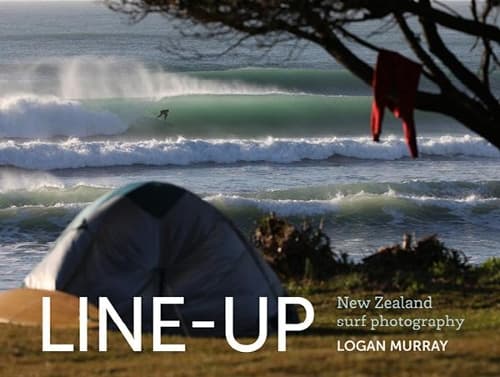Review: Line-up: New Zealand Surf Photography
Reviewed by primoz2500
With the Boomer generation slouching towards retirement, we are facing an unstoppable tsunami of publications that look back and reflect on what a long strange trip it’s been. In his second book, surf photographer Logan Murray offers a refreshingly off-beat contribution to the genre.
Line-up presents an impressive visual record of a life devoted to a singular passion: The pursuit of the perfect wave. In the 1960s, the quest took on a cosmic dimension and the more fanatical seekers lived in the spirit of Paracelsus’s comment on the Philosopher’s Stone: “The path is the Stone. Every step you take is the goal you seek.”
The path taken by Logan Murray began at Ruakākā beach in the summer of 1965 when he was pestering his older sisters’ boyfriends to give him a go on their boards. By the time he turned 13 his own second-hand board was stowed in the gear shed of the local surf club and at 18 he was working a forestry job in Rotorua, hitch-hiking every weekend to Mt Maunganui where he slept in a $1-a-night cabin and spent the daylight hours in the surf.
Lines of ground swell generated from a distant, but intense, low-pressure system near Antarctica, marching onto a beef farm. Photo: Logan Murray.
His life story serves as an introduction to a sequence of more than 100 photographs which offer a more eloquent testimony to his all-consuming passion. For hard-core surfers, to whom the book is largely addressed, the words are probably superfluous and they can dive straight into an abundance of what Murray calls “empty wave eye-candy.”
For general readers or occasional surfers, the introduction, told in an attractive down-to-earth style, is an invaluable primer for understanding how a surfer looks at a wave and also provides some amusing anecdotes on Kiwi surfing culture.
After limited success in early surfing competitions, Murray turned his attention to mastering the subtle and demanding art of surf photography. His single-minded devotion to the craft saw him win international acclaim with cover photos and feature spreads in the world’s most prestigious surf magazines. At a time when there was fierce competition for cover spots in the massively popular surfing mags, Logan Murray’s images placed him among the best in the business.
Steve Roberts took his 7-foot semi-gun, built for the bigger days, needing every inch of it here at this boulder-bottomed, big wave reef. Photo: Logan Murray.
In true Kiwi style he achieved this success by charting his own course. For Murray the photograph is always about the wave and he eschews the ubiquitous close-crop images of bronzed bodies performing feats of athleticism on their boards. Murray is a specialist in a sub-genre of surf photography known as line-up, in which the photographer evokes a sense of place and reveals something about the conditions that create the sought-after waves.
His iconic 1978 shot Puni’s Farm, which appeared as a pull-out poster in the American Surfing Magazine, is a classic of the genre. A delicate tracery of coastal scrub with silhouetted wet-suits hanging in the trees, frames the exquisite arc of a breaking wave, while sunlight raking across the wind-formed ripples highlights the curvature of the emerald water and in the background, glistening patches of light hint at nascent waves rising out of the incoming swell.
For surfing aficionados these kinds of photos are like talismans of an intense spiritual experience. They can trigger an imaginative resurrection of those ineffable moments when everything comes together in the thrill of riding a perfect wave.
“When I shot this, I recall thinking, 'This is not going to end well.' It didn't.” Photo: Logan Murray.
In his commentary on the obstacles he overcame to produce such photos, Murray uncovers a more sinister side to surfing culture. Elements in the surfing community feared Murray’s photos of clandestine surfing spots would spark an invasion and destroy Aotearoa New Zealand’s unspoiled isolation. At one stage the paranoia resulted in sustained abuse and very real threats to his life.
It is a tribute to Murray’s dedication that he did not allow the nastiness to interfere with his quest. To this day he continues his solitary peregrinations, at times donning camouflage suits, tramping for hours with heavy camera gear through farms and scrub, patiently waiting for that elusive wave.
Reviewed by Paul Simei-Barton
